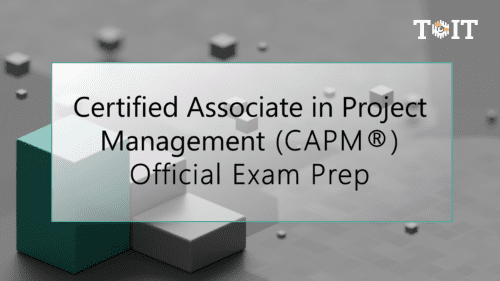Instructor | ToIT
Lean Six Sigma Green Belt
- Identify which quality improvement projects are most necessary to undertake.
- Ways to analyze quality issues in a variety of different formulas, charts, and graphs.
- The roles and responsibilities of a Six Sigma team.
16h
0
24
PM Fundamentals: Agile Project Management
- Describe Project methodologies and Life Cycles
- Use the Scrum Framework
- Understand Scrum, eXtreme Programming (XP), Lean, and Kanban
6h
0
18
PM Fundamentals: Waterfall/Predictive Project Management
- Develop a Project charter
- Plan communications, cost management, risk management, and schedule management
- Acquire, develop, and manage resources
7h
0
18
Certified Associate in Project Management (CAPM)® Official Exam Prep
- Prepare to pass the CAPM exam while completing the required 23 contact hours/PDUs
- Decipher PMBOK® Guide processes and knowledge areas
- Identify significant steps of the project life cycle
35h
0
19
Initiating a Project
- Effective pre-project initiation
- How to hold an effective kick-off meeting
- Contributing to the project charter and understanding the elements
4h
0
0
Planning for Risk Management
- How to determine your organizations’ risk thresholds and determine scoring for probability and impact
- Risk identification techniques, the pros and cons
- Creation and maintenance of a risk register
4h
0
0
Managing a Project Team
- How to run an effective kick-off meeting
- How to develop a comprehensive HR Management Plan for virtual and co-located resources
- Team acquisition negotiaion skills
4h
0
0
Balancing Time, Cost, and Scope
- Best practices for scope, time, and cost
- Planning effectively for the constraints
- Effective change control functions
4h
0
4
PM Leadership: Building a Communications Management Plan that Works
- Determining stakeholder communication requirements
- How organizational dynamics can affect communication
- People versus process
2h
0
0
PM Leadership: Leading a Cross-Cultural Virtual Team
- The differences between high and low context cultures and its effect on communication
- Work styles of different cultures
- Cultural values and how they impact projects
2h
0
0
PM Leadership: Motivating a Team of Individuals
- Best practices for scope, time, and cost
- Planning effectively for the constraints
- Effective change control functions
2h
0
0
PM Leadership: Negotiating For More
- Techniques to identify objectives and requirements to prepare for negotiation
- Techniques to identify your own negotiation personality and that of the party
- Top skills to employ during a negotiation
2h
0
0













